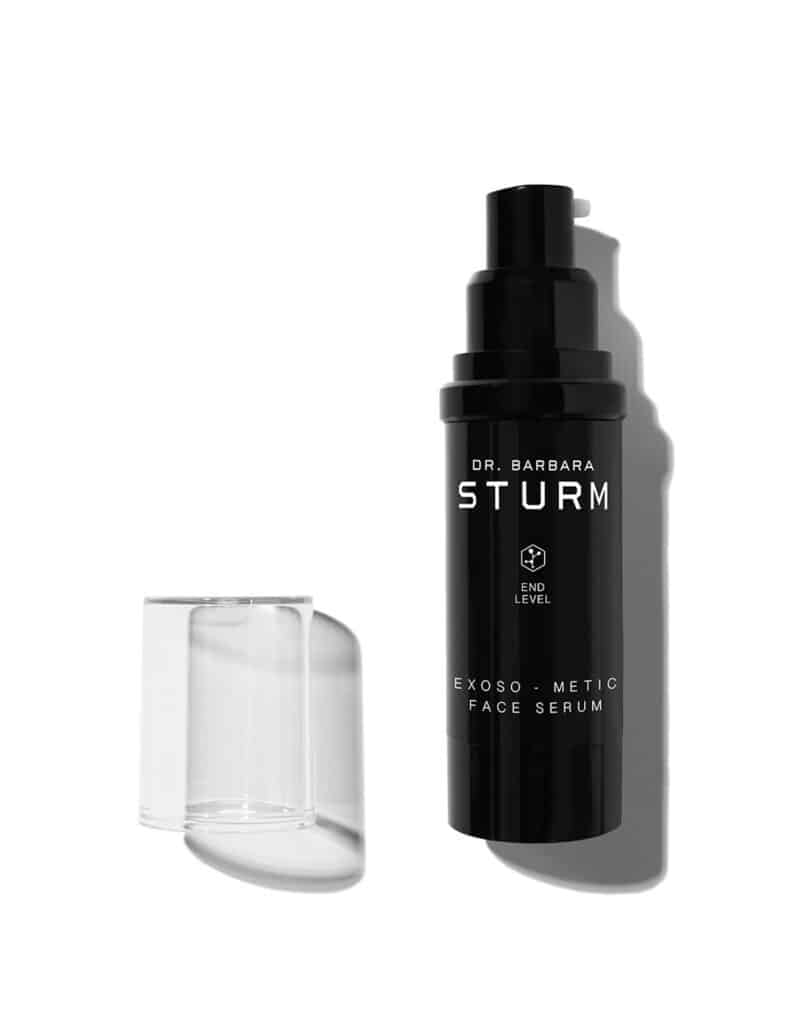written by Allison Goins, Ph.D. | Published on February 24th, 2024 at 12:00 pm
Have you heard about the buzzy new active in skincare, exosomes? Exosomes constantly showed up on a top of skincare trends predictions articles this year, and with several companies getting patents or making their way through the FDA approvals process it makes sense why this skincare ingredient is gaining popularity. And while there is tons of marketing on the benefits of exosome serums and exosome treatments; there is not as much information about where exosomes come from.
So in this article, we are answering the question of where do exosomes come from. From platelets to plant stem cells, there are quite a few different sources for exosome skincare products. But let’s talk about which ones are backed by science and which ones aren’t.
Related Post: Unveiling the Truth Behind Exosome Treatments: What You Need to Know Before You Consider This Skincare Trend
Before we jump into where exosomes come from; let’s talk about what exosomes are.
What are exosomes?
Imagine your skin cells are like bustling factories, constantly producing things to keep your skin looking young and healthy. And your cells, like any factory, sometimes make products that do not meet specs. And instead of letting them pile up, cells cleverly package them into tiny sacs. And these tiny sacs leave the cells and then trigger other cells to produce the important proteins, lipids, and even genetic material that they need to make your skin look younger and healthier.

Related Post: Understanding the Science Behind Aging in Skin: Tips for Youthful Glow
These miniature powerhouses, known as exosomes, are emerging stars in the world of skincare, promising everything from smoother wrinkles to brighter skin. But before you jump on the exosome bandwagon, it’s crucial to understand not only how they work but also where they come from.
Related Post: Topical Exosomes for Glowing Skin – Hype or Helpful?
Where Do Exosomes Come From for Skincare
Human Sources of Exosomes for Skincare
Probably the most intuitive answer to the question of where do exosomes come from is human sources. Today many of the exosomes for skincare products use exosomes derived from human cells. Specifically, there are three popular human-based sources of exosomes.
If the exosomes are from a human source they are typically from adipose-derived mesenchymal stem cells, human umbilical vein mesenchymal stem cells, and human platelets. On the ingredient list of a skincare product, this typically shows up as an extract like in the (plated) skin science exosome serum or as condition media like in the Epi.Logic and ELEVAI products.

Related Post: 7 Exosome Skincare Products: Decoding the Marketing Claims
Mesenchymal stem cells (MSCs) are a popular cell type in skin tissue engineering because they are found all over your body. They are also specifically popular for skincare due to their ability to promote wound healing and tissue regeneration. MSCs can be found in adipose, fat tissue which also makes them one of the easier sources to get stem cells from.
Umbilical veins are another source of MSCs. However, there are more sourcing challenges with MSCs from this source compared to fat tissue. Regardless of the source of MSCs, there are still ethical considerations as well as high harvesting, isolation, purification, and production costs. These challenges have led some companies to look for other sources.
Human platelet-derived exosomes are another option without some of the challenges with stem cell-derived exosomes. Platelets are present in your blood making them much easier to harvest. And studies show exosomes from platelets can potentially have the same anti-inflammatory and growth factor-like properties as stem cell-derived exosomes. This source is not as popular as MSCs today, but it shows a lot of promise because it is the least invasive way to harvest exosomes.
Related Post: Is a Growth Factor Serum in Skincare Hype or Helpful?
Synthetic Sources of Exosomes for Skincare Products
There is a pretty consistent trend in the skincare world of people looking for more sustainable ways to produce common skincare ingredients. Leveraging biotechnology to synthesize molecules from bacteria is one of the most popular ways to do this.
Hyaluronic acid is a popular skincare ingredient that is often synthesized with microorganisms. Isomer® Skincare Laboratories and Dr. Barbara Strum both sell exosome serums with exosomes from a synthetic source.
The future might hold synthetic exosomes created in the lab. Scientists are exploring ways to mimic the structure and function of exosomes using synthetic materials. This approach could bypass ethical concerns and offer greater control over exosome properties. However, exosomes are still such a new advancement in skincare and there is still a lot of testing necessary to understand their effectiveness.
Plant-Based Exosomes for Skincare
There are no plant-based exosome products for skincare today that I was able to find. However, it felt worth mentioning because it is also pretty popular to look for plant-based sources for common ingredients. And while there is not a science-based reason to look for plant-based ingredient alternatives, personal preference has definitely created a huge market.

Exosomes are not exempt from this trend and have led scientists to seek out plant-based alternatives. Some very early data has shown these exosomes may exhibit antioxidant and anti-inflammatory properties similar to human-sourced exosomes. However, there are concerns about their biocompatibility with human skin and the limited understanding of their specific biological effects. More research is needed to validate their efficacy and safety in skincare applications.
Why is the source of the exosomes for skincare products important?
In addition to being able to answer the question where do exosomes come from for skincare products, it is also important to know why the source matters. You might be wondering so how a brand decides where to get their exosomes from.
As is true with any active in skincare there are different places that brands can source their ingredients from. And depending on the source, the way the ingredients perform can be different. This is also true and arguably even more important when you are talking specifically about biologically active molecules. The source of ingredients matters for so many different reasons.

If the active works.
Ingredients that are over-processed or not treated properly during harvest and storage and become inactivated. So by the time it makes it into your hands that hero ingredient could actually be doing nothing.
If it is concentrated enough to give you the desired effect.
Clinical trials evaluate ingredients and determine what an efficacious or effective amount to get a noticeable effect. If the active you need is not present in a high enough concentration then it can be useless.
If it is pure and free of other things that could potentially be harmful.
Especially with biologics, this is a HUGE consideration. When you are harvesting and purifying biologic skincare ingredients like exosomes you have to make sure you are eliminating any residual toxins or cellular materials that your body will identify as foreign and attack.
How expensive the sourcing or extraction method is
The more expensive it is for a brand to source an ingredient, the more expensive the product is going to be. So it makes sense for brands to look to optimize their cost, but also maximize the benefits for their customers.

The availability
The last thing a brand wants to do is make you fall in love with a product and then not be able to find the raw materials they need to make it. Ensuring they can find a consistent and abundant source for their exosomes is also very important.
For all of these reasons, brands will look for different places to source their exosomes for their skincare products. Hopefully, as you continue on your skincare journey, you feel a little more informed and can answer the question where do exosomes come from for skincare products. If you have any other questions about exosomes in skincare let me know in the comments.
References:
- Lotfy, A., AboQuella, N. M., & Wang, H. (2023). Mesenchymal stromal/stem cell (MSC)-derived exosomes in clinical trials. Stem Cell Research & Therapy, 14(1), 66. https://pubmed.ncbi.nlm.nih.gov/37024925/
- Kim, D. H., Kang, S. E., Kim, M. S., Kang, Y. H., Lee, Y. H., Chung, I. H., & Jeon, Y. B. (2021). The Utilization of Human Placental Mesenchymal Stem Cell Derived Exosomes in Aging Skin: An Investigational Pilot Study. Journal of Surgical Research, 1388(2), 39-47. https://exosomes.com/wp-content/uploads/2021/04/JSUR-1388-2.pdf
- Yu, W., Li, M., Li, M., Guo, W., Li, X., Zhao, Y., … & Zheng, G. (2021). Topical Application of Exosomes Derived from Human Umbilical Cord Mesenchymal Stem Cells in Combination with Sponge Spicules for Treatment of Photoaging. International Journal of Nanomedicine, 16, 8385-8398. https://doi.org/10.2147/IJN.S249751
- Yang, T., Zhang, X., Wu, H., Chen, W., Liu, S., Liu, H., … & Wu, M. (2022). Exosomes based advancements for application in medical aesthetics. Frontiers in Bioengineering and Biotechnology, 10, 1083640. https://www.frontiersin.org/articles/10.3389/fbioe.2022.1083640/full
- Azam, F. (2020). Needle-Free Injection of Exosome-based candidates move into the clinic. Nature Reviews Drug Discovery, 19(3), 156-157. https://www.ncbi.nlm.nih.gov/pmc/articles/PMC7032013/
- Kim, B.-J., Kim, W.-C., Song, Y.-B., Sung, J.-H., Kwon, T.-G., Oh, Y.-M., & Bae, J.-M. (2023). Efficacy of combined treatment with human adipose tissue stem cell-derived exosome-containing solution and microneedling for facial skin aging: A 12-week prospective, randomized, split-face study. Journal of Cosmetic Dermatology, 22(2), 380-388. https://pubmed.ncbi.nlm.nih.gov/37377400/
- Kim, K. H., & Sung, J. H. (2023). A Review of exosomes and their application in cutaneous medical aesthetics. Journal of Cosmetic Dermatology, 22(3), 801-814, 14(1), 66. https://pubmed.ncbi.nlm.nih.gov/37498301/
- Ruri Lee, Hae Ju Ko, Kimin Kim, Yehjoo Sohn, Seo Yun Min, Jeong Ah Kim, Dokyun Na & Ju Hun Yeon (2020) Anti-melanogenic effects of extracellular vesicles derived from plant leaves and stems in mouse melanoma cells and human healthy skin, Journal of Extracellular Vesicles, 9:1, DOI: 10.1080/20013078.2019.1703480
- Proffer SL, Paradise CR, DeGrazia E, Halaas Y, Durairaj KK, Somenek M, Sivly A, Boon AJ, Behfar A, Wyles SP. Efficacy and Tolerability of Topical Platelet Exosomes for Skin Rejuvenation: Six-Week Results. Aesthet Surg J. 2022 Sep 14;42(10):1185-1193. doi: 10.1093/asj/sjac149
- Zhang, Y.; Zhang, M.; Yao, A.; Xie, Y.; Lin, J.; Sharifullah, F.; Hong, Y.; Chen, H.; Cheng, F.; Lai, W. Circ_0011129 Encapsulated by the Small Extracellular Vesicles Derived from Human Stem Cells Ameliorate Skin Photoaging. Int. J. Mol. Sci. 2022, 23, 15390. https://doi.org/10.3390/ijms232315390
